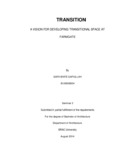| dc.contributor.advisor | Khan, Ehsan | |
| dc.contributor.advisor | kibria, Naim Ahmed | |
| dc.contributor.advisor | Faruk, Mohammad | |
| dc.contributor.advisor | Sultana, Sheikh Rubaiya | |
| dc.contributor.author | Safiullah, Safa Binte | |
| dc.date.accessioned | 2014-09-07T10:06:19Z | |
| dc.date.available | 2014-09-07T10:06:19Z | |
| dc.date.copyright | 2014 | |
| dc.date.issued | 2014-08 | |
| dc.identifier.other | ID 09308004 | |
| dc.identifier.uri | http://hdl.handle.net/10361/3541 | |
| dc.description | This thesis is submitted in partial fulfillment of the requirements for the degree of Bachelor of Architecture in Architecture, 2014. | en_US |
| dc.description | Cataloged from PDF version of thesis. | |
| dc.description | Includes bibliographical references (page 108). | |
| dc.description.abstract | Certain spaces relate to people in ways that are complex. The complexity arises when spaces require certain forces to create a desired dialogue with the users. Many such spaces fall under the ‘transitional space’ category, usually lacking an experiential sense of ownership. In the light of the ‘non-place’ theory related to urban context, the spaces of transition remain ‘dead’ until they are ‘designed’ to guide the subconscious of the user. The aim of the project is to design an important transitional space within the city context and provide a vision as to how a non-place could be transformed and developed into providing quality experiential values to the users, thus creating a dialogue between people, space and events.
As a threshold between 'Space' and 'Time', architecture serves as a reference point within our conscious frame work. Interest in architecture today is too often confined to what is pretty or aesthetically pleasant. The forces behind the creation of an architecture that is both a place of transition and interaction; a place that both philosophically and programmatically intends to enhance the life of the town’s population by promoting social and civic togetherness. In context of Dhaka city, for the large number of people there is no public recreational place where people can practice, exercise, participate or at least observe. The basic idea is to integrate the development projects with the intervention of recreational urban facilities within a transition and merge it with city scale development projects to create a connected structure of the service of the city. As this is a city scale project and the site is Farmgate, so the intervention will be both in macro (urban issues) as well as micro (architecture/ built form) scale. | en_US |
| dc.description.statementofresponsibility | Safa Binte Safiullah | |
| dc.format.extent | 109 pages | |
| dc.language.iso | en | en_US |
| dc.publisher | BRAC University | en_US |
| dc.rights | BRAC University thesis are protected by copyright. They may be viewed from this source for any purpose, but reproduction or distribution in any format is prohibited without written permission. | |
| dc.subject | Architecture | en_US |
| dc.title | Transition: a vision for developing transitional space at Farmgate | en_US |
| dc.type | Thesis | en_US |
| dc.contributor.department | Department of Architecture, BRAC University | |
| dc.description.degree | B. Architecture | |

